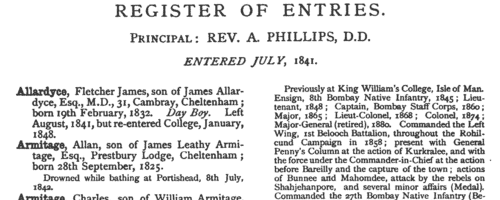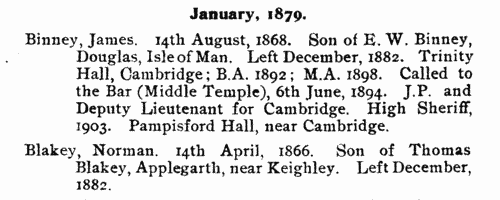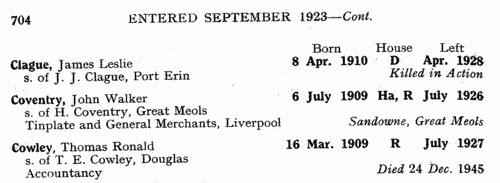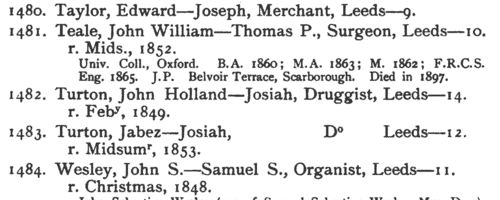Add this eBook to your basket to receive access to all 1,058 records. Our indexes include entries for the spelling chadwick. In the period you have requested, we have the following 1,058 records (displaying 791 to 800): These sample scans are from the original record. You will get scans of the full pages or articles where the surname you searched for has been found. Your web browser may prevent the sample windows from opening; in this case please change your browser settings to allow pop-up windows from this site. Disputed Estates
(1887)
Notices from the Court of Chancery as to the disposition of disputed estates in England and Wales. | Sample scan, click to enlarge

| Estates of the Deceased
(1887)
Distribution of the assets of the deceased: giving the names of the deceased and trustees &c. England and Wales | Sample scan, click to enlarge

| Partnerships Dissolved
(1887)
Dissolution of trading partnerships, or removal of a partner from a business, in England and Wales | Sample scan, click to enlarge

| Associates of the Royal Institute of British Architects
(1888)
The Kalendar of the Royal Institure of British Architects for 1888-9 includes this list of members, corrected to 8 November 1888. It is in six parts: Honorary Fellows, Fellows, Honorary Associates, Associates, and those nominated by ballot to become Fellows and Associates. The names throughout are given in full, surname first, with current address. Those members marked * had been previously Members of Council. Members of the present Council were printed in full capitals. Those marked with a dagger were in possession of a certificate of competency to act as a District Surveyor or a Building Surveyor; those with a double dagger had passed the institute's architecture examination. (L) indicates a life member. "All gentlemen engaged in the study or practice of Architecture, before presenting themselves for election as Associates, shall be required to have passed an Examination according to a standard fixed from time to time by the Council." | Sample scan, click to enlarge

| Inhabitants of county Armagh
(1888)
Bassett's Book of Antrim is a directory listing traders, farmers and private residents in the county, with notes on local manufacture and for anglers and sportsmen. | Sample scan, click to enlarge

| Anglicans in Salford and their children
(1889)
The parish magazine of the populous Anglican parish of Salford St Matthias contains not only parish news and notices, but also lists of Baptisms, Marriages and Deaths. The parish was divided into 38 districts for the Christian Workers' Association, and the districts are listed, with the names of the streets, and the names and addresses of the district visitors. The Church Decoration and Window Accounts include a long list of donations by parishioners. The Sunday School prize lists give the names of many of the children, arranged by class; and there is a long prize list for the year for boys and girls attending the Anglican day and infants schools at Broughton Road and Silk Street. The parish comprised Broughton Road, St Simon's Street, Back Sandon Street, Wood's Buildings, Sandford Street, Watkin Street, Harriet Street, Brougham Street, Wheat Hill Street, Rose Street, Pink Street, Silk Street and Back Silk Street, Adelphi Street, Flax Street, Ann Street, Diamond Street, Lester Street, Cliburn Street, Sagar Street and Back Sagar Street, Pine Street, Matthew's Buildings, Blackburn Street, Blackburn Place, North James Henry Street, Pea Street, Cannon Court, Arlington Street and Back Arlington Street, Silk Place, Russell Street, Artillery Street, Gun Street, Bow Street, Chestnut Street, North Charles Street, Peter Street, North Thomas Street, Ogden Street, North Cable Street, Cannon Street, Rockville Street, Barnet Street, Brook Street, McIntyre Square, Burton Street, Devine Street, Methvin Street, Skellorn Street, North Hill Street, Briggs Street, Simms Street, Allendale Street, Francis Terrace, Marshall Terrace, Albert Terrace, North George Street, Alexander Street, Albert Street, Marshall Street, Mount Street, Mayers Street, Peru Street, Reservoir Terrace, John Street, Richmond Terrace, Richmond Row and Back Richmond Row, Ford Lane, Ford Land View, Richmond Hill, High Holborn Terrace, Perseverance Place, Williamson Street, Willow Street, and Salford Street. | Sample scan, click to enlarge

| Boys entering Cheltenham College
(1889)
Cheltenham College 'was founded in order to provide for the sons of gentlemen a Classical, Mathematical, and General Education of the highest order, on moderate terms, in strict conformity with the principles and doctrines of the Church of England.'
Andrew Alexander Hunter, the college registrar, compiled the first edition of the College Register in four parts from 1883 to 1886: these merely listed the boys by term of entry, with their dates of birth and names and addresses of their fathers. Circulars were also sent out to all Old Cheltonians whose addresses were known, requesting additional details. On the basis of the returns from these and Hunter's further researches, this much fuller register was published in 1890.
The information after each boy's name is given (where known and applicable) in this format: father's full name and address as of the time the boy entered the college; class and department on entering the college (classes being number from 1 downwards, and these again divided into A and B, some into C and D, others into P (Principal's side) and V. P. (Vice-Principal's side) - 1A was the highest class in each department: besides this, certain others were called Addiscombe, Woolwich, Civil, Direct, Line, Sandhurst, Naval, Special, Preparatory, Latin, and India Civil) and the same on leaving, name of Boarding House (or 'Day Boy'), scholastic and athletic honours attained at the college, and subsequent career (including date and place of death, or present address in 1890, if known).
Of course, in the case of these boys entering the school in the last few years before 1890 their career lay in the future, and the information gives relates only to their parentage and their time at school.
| Sample scan, click to enlarge

| Boys entering Giggleswick School
(1889)
The school at Giggleswick in the West Riding of Yorkshire dates from at least 1507, but no register of the boys attending there has survived earlier than one started by the headmaster, the reverend George Style, in 1875. When the bursar, H. L. Mullins, prepared this, 'The Giggleswick School Register', printed in 1913, he was able to compile general details of some scholars from earlier years, but the concerted, reasonably complete, account starts in 1859. The details are arranged by term of entry, then alphabetically by surname and christian name. Typically each description gives full name; date of birth; name and address of father; date of leaving. Where known, Mullins then added a brief career synopsis, present address in 1913, or date of death. From 1869 onwards boarders were admitted to the school, and where it is known that a boy was a day scholar, the word (Town) is added after his name. | Sample scan, click to enlarge

| Boys entering King William's College, Isle of Man
(1889)
King William's College at Castletown on the Isle of Man was established in 1830. By 1928 about 290 boys were being educated there, 'of whom three-fourths are boarders, and the remainders sons of natives or residents in the Island.' Boys entered the junior school about 9 or 10 years of age, the upper school about 13; boys over 13 were not admitted 'unless attainments and character are specially satisfactory'. There were 'several nominations for the sons of clergy and others'.
Editions of the college register were published in 1905 and 1927. When this third edition was prepared, in 1956, it was felt unnecessary to repeat the whole of the register from 1830 onwards, a new starting point being chosen as September 1886, when the reverend Frank Bridgman Walters took office as principal.
The items are arranged alphabetically within term of entry; surname is given first, in bold, and then full christian names; then, to the right, in bold, precise date of birth, school house, and month of leaving the school. The abbreviations for houses are: C, Colbourne; D, Dickson; H, Hunt; Ha, Hangoside; J, Junior House; R, Raglan; S, School House (formerly Principal's); T, town houses occupied by masters who took in boys prior to September 1889; Tr, Trafford's; W, Walters.
Each entry then gives the boy's father's name (surname and initials) and address at that time; school honours (such as Prae., praepositor, XI, school cricket team); a career synopsis; and finally, in italics, to the right, year of death, or present address in 1956, if known. | Sample scan, click to enlarge

| Boys entering Leeds Grammar School
(1889)
The admission books for Leeds Grammar School from 1820 to 1900 were edited by Edmund Wilson and published in 1906. The series of registers is almost complete for the period, there being in addition admission registers for the Lower (or Commercial) Department from 1856 to 1865, and lists of boys in the school in 1856, and in the Commercial Department in 1861. The entries are arranged by date or term of admission: a sequential number is given first, then surname, christian name, and, after a dash, father's christian name, occupation, and address; another dash, and then the age of the boy at admission, and often his year of leaving (with the abbreviation r. for 'removed' or 'left'). r.* means left without notice; (o) or S. or Stranger or Foreigner indicates a boy not on the foundation. The editor was unable to divine the meaning of the abbreviation (Q) or the asterisks prefixed to most entries in 1856 to 1860, but dutifully copies them into the text. In smaller type he then proceeds, where possible, to add some information about the boy's subsequent career. | Sample scan, click to enlarge

|
Research your ancestry, family history, genealogy and one-name study by direct access to original records and archives indexed by surname.
|











